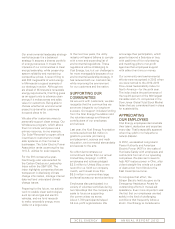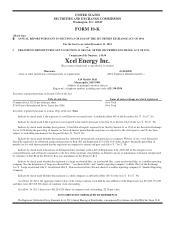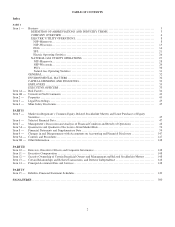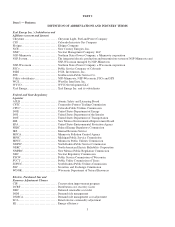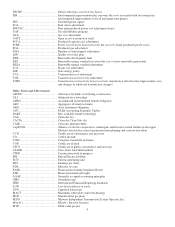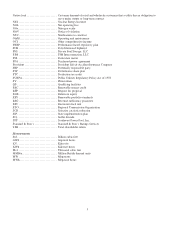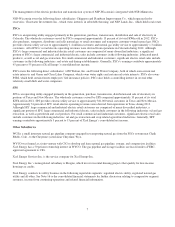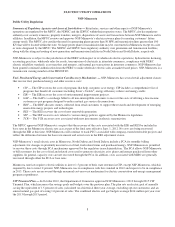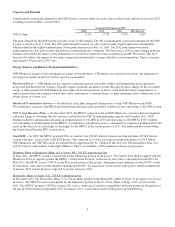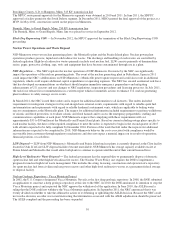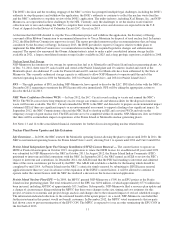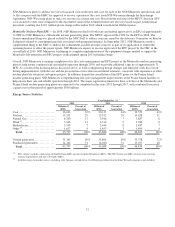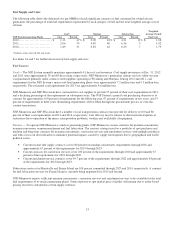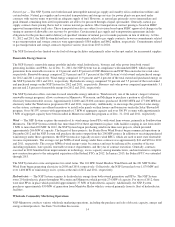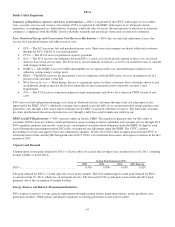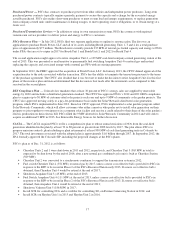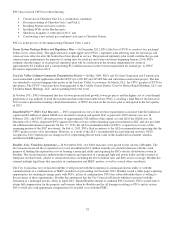Xcel Energy 2012 Annual Report Download - page 18
Download and view the complete annual report
Please find page 18 of the 2012 Xcel Energy annual report below. You can navigate through the pages in the report by either clicking on the pages listed below, or by using the keyword search tool below to find specific information within the annual report.8
ELECTRIC UTILITY OPERATIONS
NSP-Minnesota
Public Utility Regulation
Summary of Regulatory Agencies and Areas of Jurisdiction — Retail rates, services and other aspects of NSP-Minnesota’s
operations are regulated by the MPUC, the NDPSC and the SDPUC within their respective states. The MPUC also has regulatory
authority over security issuances, property transfers, mergers, dispositions of assets and transactions between NSP-Minnesota and its
affiliates. In addition, the MPUC reviews and approves NSP-Minnesota’s electric resource plans for meeting customers’ future
energy needs. The MPUC also certifies the need for generating plants greater than 50 MW and transmission lines greater than 100
KV that will be located within the state. No large power plant or transmission line may be constructed in Minnesota except on a site
or route designated by the MPUC. The NDPSC and SDPUC have regulatory authority over generation and transmission facilities,
along with the siting and routing of new generation and transmission facilities in North Dakota and South Dakota, respectively.
NSP-Minnesota is subject to the jurisdiction of the FERC with respect to its wholesale electric operations, hydroelectric licensing,
accounting practices, wholesale sales for resale, transmission of electricity in interstate commerce, compliance with NERC
electric reliability standards, asset transfers and mergers, and natural gas transactions in interstate commerce. NSP-Minnesota has
been granted continued authorization from the FERC to make wholesale electric sales at market-based prices. NSP-Minnesota is a
transmission owning member of the MISO RTO.
Fuel, Purchased Energy and Conservation Cost-Recovery Mechanisms — NSP-Minnesota has several retail adjustment clauses
that recover fuel, purchased energy and other resource costs:
• CIP — The CIP recovers the costs of programs that help customers save energy. CIP includes a comprehensive list of
programs that benefit all customers including Saver’s Switch®, energy efficiency rebates and energy audits.
• EIR — The EIR recovers the costs of environmental improvement projects.
• GAP — The GAP is a surcharge billed to all non-interruptible customers to recover the costs of offering a low-income
customer co-pay program designed to reduce natural gas service disconnections.
• RDF — The RDF allocates money collected from retail customers to support the research and development of emerging
renewable energy projects and technologies.
• RES — The RES recovers the cost of new renewable generation.
• SEP — The SEP recovers costs related to various energy policies approved by the Minnesota legislature.
• TCR — The TCR recovers costs associated with new investments in electric transmission.
The MPUC approved NSP-Minnesota’s request that the recovery of the costs associated with the EIR and RES be included in
base rates in the Minnesota electric rate case as part of the final rates effective Sept. 1, 2012. No costs are being recovered
through the EIR at this time. NSP-Minnesota will continue to track PTCs associated with company-owned renewable projects and
reflect the difference between the base rate amount and actual costs in the RES adjustment clause.
NSP-Minnesota’s retail electric rates in Minnesota, North Dakota and South Dakota include a FCA for monthly billing
adjustments for changes in prudently incurred cost of fuel, fuel related items and purchased energy. NSP-Minnesota is permitted
to recover these costs through FCA mechanisms approved by the regulators in each jurisdiction. The FCA allows NSP-Minnesota
to bill customers for the cost of fuel and related costs used to generate electricity at its plants and energy purchased from other
suppliers. In general, capacity costs are not recovered through the FCA. In addition, costs associated with MISO are generally
recovered through either the FCA or base rates.
Minnesota state law requires electric utilities to invest 1.5 percent of their state revenues in CIP, except NSP-Minnesota, which is
required by law to invest 2 percent. NSP-Minnesota was in compliance with this standard in 2012 and expects to be in compliance
in 2013. These costs are recovered through an annual cost-recovery mechanism for electric conservation and energy management
program expenditures.
CIP Triennial Plan — In October 2012, the Department of Commerce approved NSP-Minnesota’s 2013 through 2015 CIP
Triennial Plan, which increases the savings goals and budgets over the previous plan. The plan sets an electric goal of annually
saving the equivalent of 1.5 percent of sales (calculated on a historical three-year average, excluding opt-out customers) and an
annual natural gas goal of saving 1.0 percent of sales. The combined electric and gas budgets average $104 million per year over
the 2013 through 2015 period.



